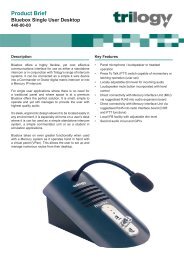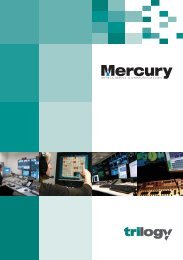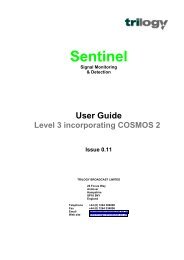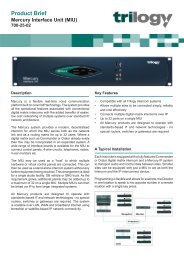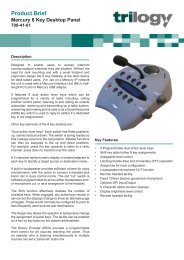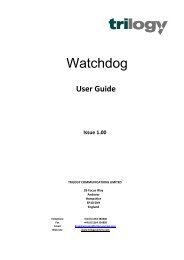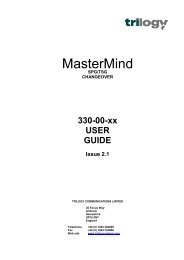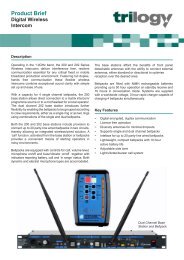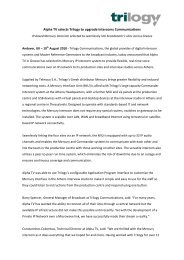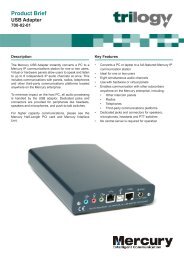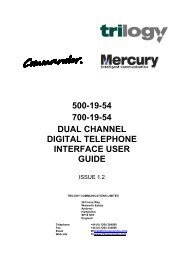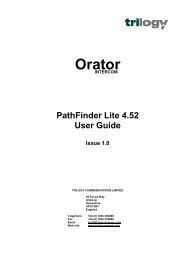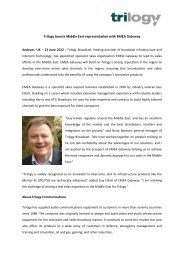PathFinder Software Configuration Guide - Trilogy Communications
PathFinder Software Configuration Guide - Trilogy Communications
PathFinder Software Configuration Guide - Trilogy Communications
- No tags were found...
You also want an ePaper? Increase the reach of your titles
YUMPU automatically turns print PDFs into web optimized ePapers that Google loves.
<strong>PathFinder</strong> Version 4.22 User <strong>Guide</strong>By default, members in the IFB Trigger Source list are set to none, therefore when theytrigger their crosspoint to the IFB destination the audio will mix with the IFB return audio. Toset the IFB trigger to break the return audio, the Trigger Action level needs to be set to alevel of 1, 2 or 3.14.3 Multiple Return Audio SourcesIt is possible to have up to 16 Return Audio sources configured to an IFB. Each return audiocrosspoint is normally made to the IFB destination. All the return audio crosspoints arebroken when a level 1 – 3 trigger source activates the IFB.14.4 Multiple IFB Trigger SourcesOnce the IFB destinations have been selected, the Trigger Action needs to be set in the IFBTrigger Source list. As explained above, setting the IFB Trigger Action to none causes theTrigger Source audio to mix with the Return audio. To cause the Trigger source audio tointerrupt the return audio, the Trigger Action needs to be set to a priority level.The Trigger Action priorities are such that priority Level 1 will override a priority Level 2, etc.Therefore any priority 1 panel speaking to the IFB destination will not only interrupt thereturn audio feed but also interrupt trigger sources speaking with a priority of 2 or 3. A panelset to priority none will not be interrupted.To confirm how the IFB will actually work, click the appropriate row of the Breaks column.This will display, using a symbol, all the trigger sources that will be overridden by theselected trigger source.As IFB destinations are added, the list of potential sources to the IFB destinationautomatically updates to include these sources. This allows priorities to be assigned asrequired.Priorities are such that priority 1 is higher than priority 2, etc. Therefore any priority 1 panelspeaking to the IFB will not only interrupt the return audio feed, but also sources of priority 2or 3.The special none category is provided to ensure that a source with this priority will not beinterrupted by other sources speaking to the IFB destination(s). The audio contribution fromsuch none sources thus mixes at all times with the return audio feeds.Since the Commander system allows users to locally re-assign their keys to targets, whichmay be an IFB destination(s), it can be useful to specifically add sources to the list althoughthey do not currently have a key to speak to the IFB.This may be done via the IFB+ button (and conversely removed using the IFB- button). Apriority may then be pre-assigned.In addition, the default priority may be set as required. This ensures that as new sourcestarget the IFB destination(s), - whether by the user re-assigning keys, or from within<strong>PathFinder</strong> - they take on a priority appropriate to the installation.To determine how the IFB will actually work, the “breaks” column on the form may be used.Clicking an appropriate row of the “breaks” column will cause all sources that would beinterrupted in addition to the return audio sources to be displayed with a symbol:Page 80 of 80 Issue 1 <strong>Trilogy</strong> <strong>Communications</strong> Limited




